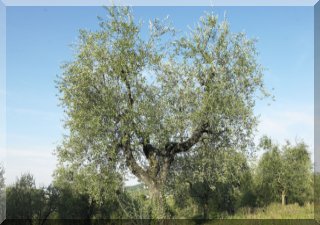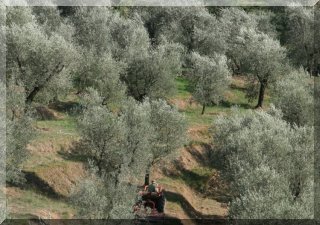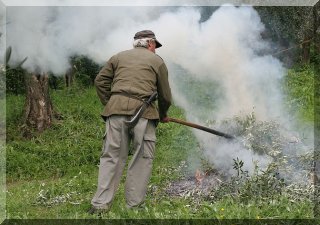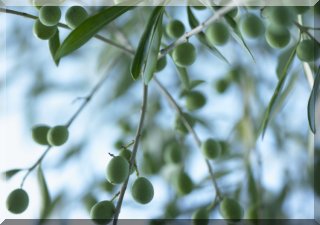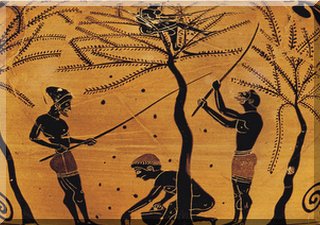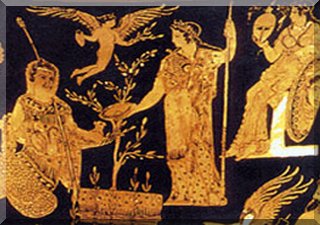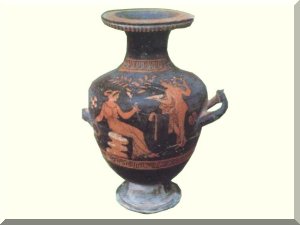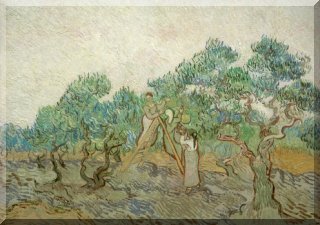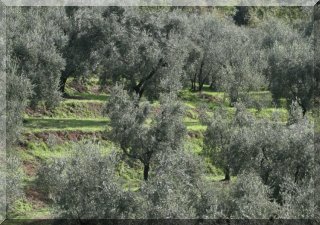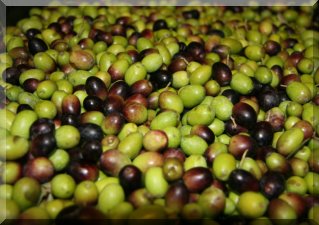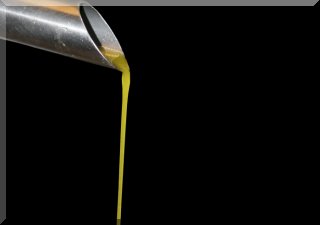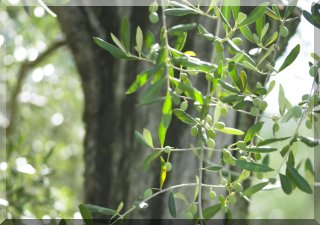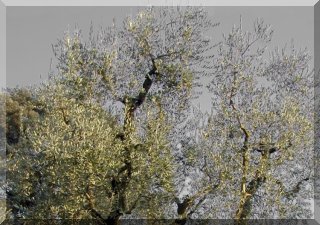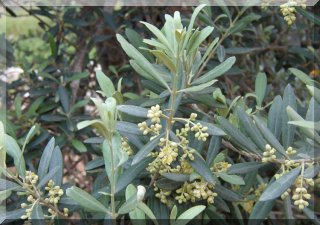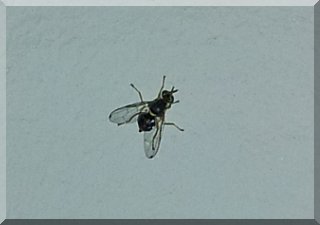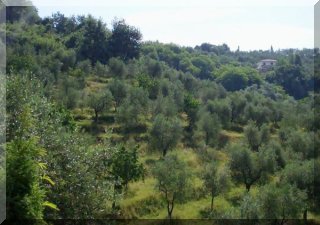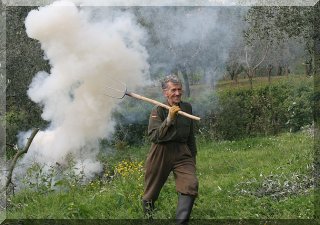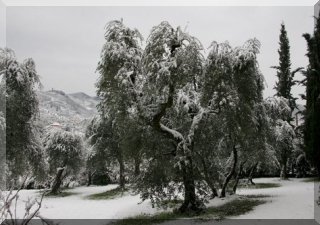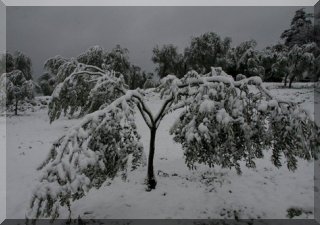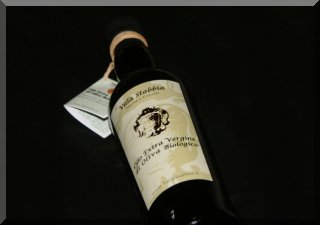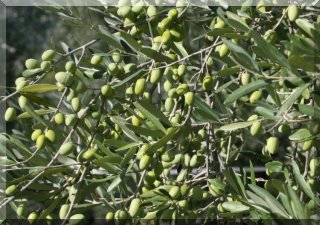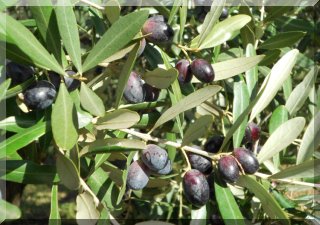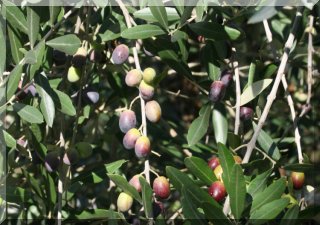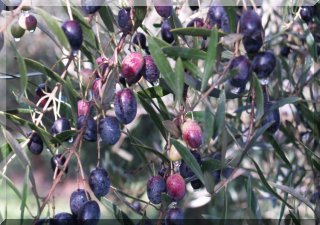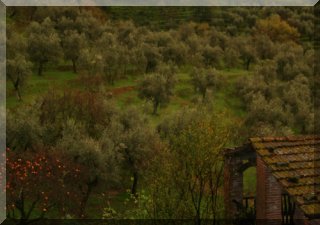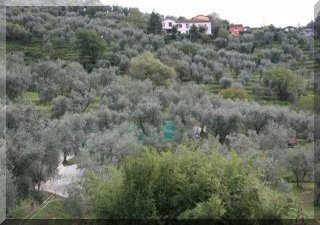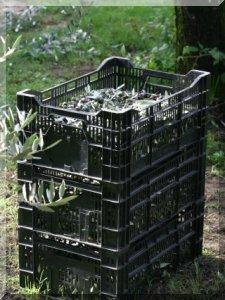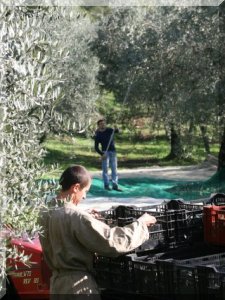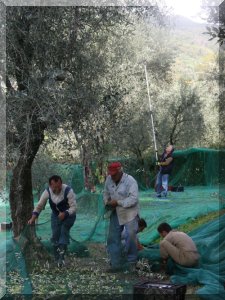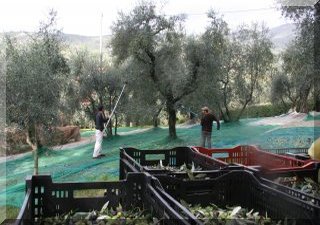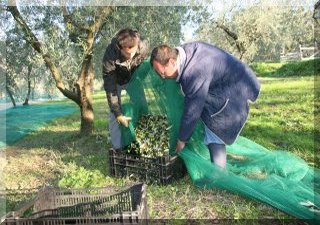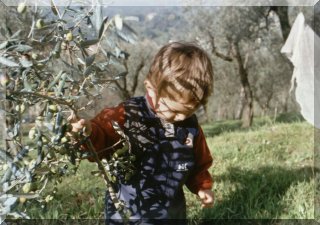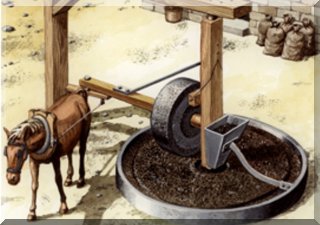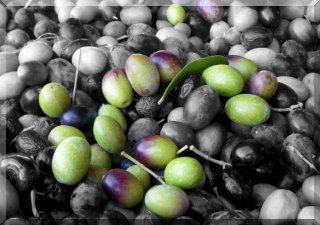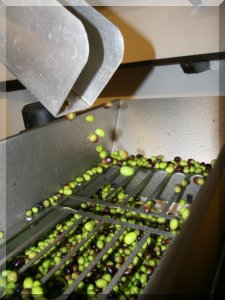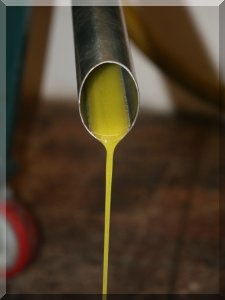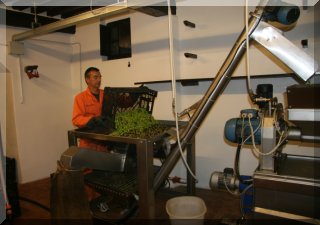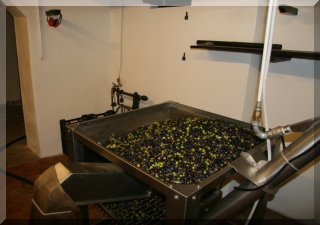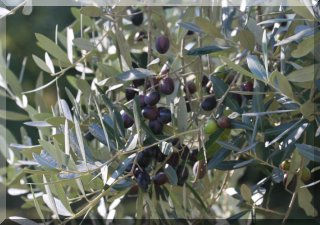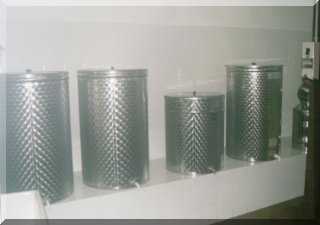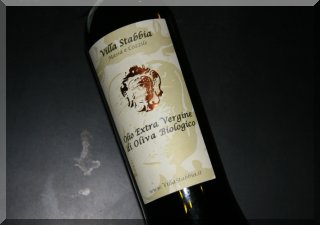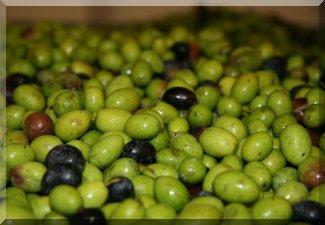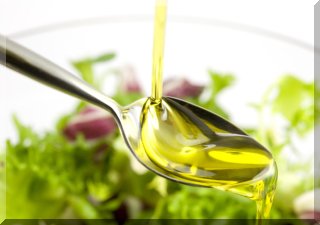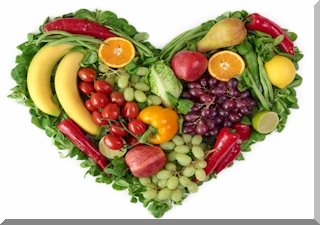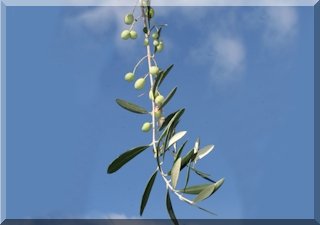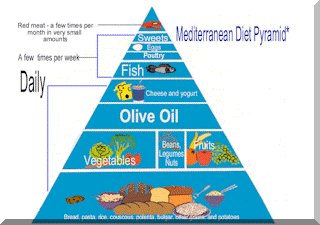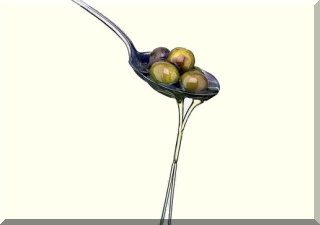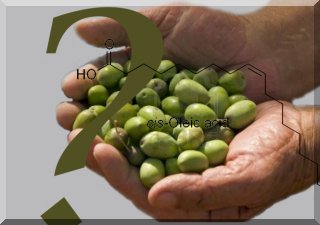Organic Farming at Villa Stabbia
Though organic farming is more expensive and yields a smaller production, it is vital to our philosophy of living a simple life, follow the true rhythm of nature whilst preserving our environment for future generations.Villa Stabbia philosophy Respect for nature and the environment has always been a part of the way Villa Stabbia has been run.
Though the farm has always been organic, it was finally decided in 2000 to get it certified as such.
Organic farming uses modern, yet natural, plant-protection methods, which avoid the use of pesticides.
With olive trees as old as 250 to 300 years, it is safe to say that olive production always has been an integral part of the agriculture at Villa Stabbia.
Back in 1990 the family took the first step towards being certified as organic agriculture, by monitoring the parasite activity, thus attacking them only when required, and not as traditionally dictated by the calendar.
The next and final step was to totally remove the usage of chemical products. This was completed in 2002, when the farm was certified organic.
Today the grass is mechanically cut and used as fertilisers alongside with other organic compost. Even the leftovers from harvesting and pruning are useful to fight parasites, whilst the remains from the oil pressing - are all composted and returned to the soil.
Due to a bad fire some years ago, at present only 2500 olive trees on about 10 hectare are producing oil. However the "new babies" are growing up fast and more are forthcoming and should start to yield some fruits (hopefully) soon.
The resulting pure gourmet olive oil at Villa Stabbia is thus the product of olives picked from trees that have remained organically grown for ages.
Please click here if you wish to purchase the oil or have any questions
The History of Olive Oil - by Villa Stabbia
The mystical glow of olive oil has illuminated history. Homer called it "liquid gold" and the general belief was that it conferred strength and youth. Athletes ritually rubbed it all over their body. It has been seasoning, medicinal, magical, an endless source of fascination and wonder and the fountain of great wealth and power for the peoples of the Mediterranean. According to legend, the olive tree was a gift from Athena, the wise warrior-deity who also recognised the power of peace.Grey-eyed Athena competed with Poseidon for the affections of the Greeks, and had offered the versatile olive in response to the sea god's gift of a saltwater well. The olive proved the better gift, offering refuge from the harsh sun, crowning the heads of champions, anointing warriors and athletes with its splendid golden tone.
When athletes rubbed it over their bodies before competition, it protected their skin from abrasions and the elements. According to Hippocrates, the "father of medicine", olive oil could heal numerous ailments, among them mental illness, and what Hippocrates charmingly referred to as "the diseases of women". It offered light when burned and was used by priests to consecrate the dead. The trees were so sacred that those who cut one down were condemned to death.
The olive tree was native to Asia Minor and spread from Iran, Syria and Palestine to the rest of the Mediterranean basin 6,000 years ago. It is among the oldest known cultivated trees in the world - being grown before the written language was invented.
It is difficult however to pinpoint the beginning of man's relationship with the pitted fruit, though popular use most likely began in the southwest Mediterranean. Olive pits and wood fragments have been found in tombs throughout this area.
Although brought to Southern Italy by the Greeks before, actual cultivation did not occur until the mid-seventh century in Tuscany. The Etruscans inhabited part of western central Italy, roughly the area of modern Tuscany. They learned much from the Greeks but developed the olive culture further to suit their own needs in the northern regions of Italy.
Archaeologically, the Etruscans are famous for their tombs, frescoes and pottery, and it is via these vase paintings and frescoes that some interesting glimpses of the Etruscan life emerges, including their agriculture. Etruscans, young and old, were harvesting olives by beating the tree branches with long sticks to make the fruit fall to the ground, where they were collected by young boys with baskets. Other images found show boys climbing the trees and shaking the olive branches to make the fruit fall. However, at that time olive oil was used not so much for food, but rather for lighting, cosmetics and ointments.
Olive trees were planted in the entire Mediterranean basin under Roman rule. According to the historian Pliny, Italy had "excellent olive oil at reasonable prices" by the first century A.C, "the best in the Mediterranean," he maintained. Actually, olive oil was the hottest commodity in the ancient world, and advanced ships were built for the sole purpose of transporting it to trading posts around the Mediterranean.The Roman Empire's prodigious growth and colonial expansion brought trees to Spain and other colonies in the Iberian Peninsula, and was already in use by the Berber of North Africa when the Romans arrived. With the fall of the Roman Empire in the 5th century, olive cultivation declined for a thousand years.
In the Middle Ages, olive oil steadily regained its role, when the Roman Catholic Church started to use it in rituals and anointings. The name Christ comes from the Greek word Kristos - the anointed one.
Due to geographic and climatic limitations, the region of northern Tuscany seems to have been the inland limit of olive cultivation on the Italian peninsula. Despite the harsh climate, Tuscan olives were still grown in great numbers and even favoured by some because of their distinct taste and character, even though by modern standards (and perhaps in ancient times as well) the yield from northern trees is some 10 times less than in southern Italy.
Today, we know that the Tuscan olive oil is especially low in acidity when compared with its southern counterpart, and this may help explain why northern olive oil had such a favourable following over the past millennia.
Due to the Romans and their expanding Empire, the entire known world was introduced to olive cultivation and the benefits derived from the little green fruit. Olive trading routes grew up, and gradually Tuscany's landscape took on its silver-crowned appearance.Only recently have non-Mediterranean consumers begun to appreciate premium quality extra virgin olive oils. Unfortunately, with the growing interest in olive oil come a lot of mythology, hype, and bad information.
As it happened with wine some forty years ago, the increasing awareness and appreciation of the product created a demand for quality wine. Similarly there is a learning curve regarding the olive oils. The majority of oils sold on the non-Mediterranean market are unfortunately inferior products bearing little resemblance to the rich full flavour oils that are an essential ingredient to fine Mediterranean cuisine.
Without question, food critics, chefs and connoisseurs tend to agree that some of the most flavoury and highest quality oils come from the region of Tuscany in Italy.
Even today, just as in ancient times, the olives from these incredible trees are harvested and made into oil here at Villa Stabbia, just as they were by Etruscans, Romans.....
Please click here
if you wish to purchase the oil or have any questions
The Olive Trees at Villa Stabbia
The olive branch has always been a symbol of peace and the fruit itself an emblem of wealth and prosperity. A low knotty trunk characterises the olive tree. The leaves are coloured a beautiful gloss green, silvery white on the underside.The trees can grow to 15 meters, but on average they are pollarded at between 4 and 6 meters to ease the harvesting. Olives need very little water, and can search it out at great distances from the tree.
Olive trees have an almost titanic resistance, a vital force that renders them nearly immortal. Despite the near 0 degrees winters and burning summers, despite truncations, they continue to grow, proud and strong reaching towards the sky, bearing fruit that nourishes and heals inspires and amazes. Temperate climactic conditions, characterized by warm dry summers and rainy winters, favour plentiful harvests; stone, drought, silence, and solitude are the ideal habitat for the majestic olive tree.
The best olive oil comes from the juice of olives from low growing trees, with a lot of room and sun so that the fruit can mature correctly and so that each tree receives sufficient moisture and nutrients from the soil. In organic farming only natural fertilizers are used.
The olive tree is a slow growing tree, which fills during the first 7 years of its life and has a growing productivity between the age of 7 and 35 years. From 35 to 150 years the tree reaches maturity and full production and beyond 150 years the olive tree starts aging though with a remarkable productivity for centuries and sometimes for thousands of years. The olive trees production is cyclical with more production in one year and significantly less the following year.In April a multitude of small, white perfumed flowers appear in groups under the preceding year's leaves. They only last a few weeks. One olive is born for around every 50 flowers.
In mid October the harvest starts; the olives must be picked before they become fully ripe as the resulting oil will be rich in un-saturated fat, anti-oxidation substances and with lower acidity and better organoleptic properties.
Olive groves require care throughout the year and the work is labour-intensive. Almost all operations are totally manual and that is the main reason for the high prices of olive oil.
For all olive growers, the most feared enemy is the Olive Fly (Dacus Olei). In certain years this insect can destroy the entire crop. The larvae cause premature fruit drop and yield reduction. An infestation seriously affects oil volume, alters its colour and increases acidity.
Against the fly, farmers can use anti-parasites, poisoned bait and other parasites of the olive fly that attack its larvae during summer. There is absolutely no use of pesticides at Villa Stabbia, so the only real alternative to prevent the Olive Fly from infesting and destroying the whole crop is to pick before the fly arrives. Luckily, as mentioned before, olives picked before they are fully ripe, also produce a better oil, healthier and tastier.
Another interesting usage of the natural resources to fight another parasite, are the leftovers from the pruning of the trees. The branches are left on the round near the tree, as the parasite Phleotribus scarabeoides, which is constantly looking for an olive tree to lay its eggs in, will use the cut-off branch instead of infesting the tree. A month later, once the egg-laying season is over, the branches are collected and burnt.
Please click here
if you wish to purchase the oil or have any questions
The Various Types of Olives at Villa Stabbia
Just as fine wines are made from a vast variety of grapes that determine their flavour, so are fine olive oil also made from a vast variety of olives that produce distinct differences in flavour. Some oils are made from a single fruit. Other more complex oils are made from several types of olives. The actual proportions that make a specific oil unique are a closely guarded secret.
At Villa Stabbia, the following four traditional Tuscan olive
tree varieties are grown:
Frantoio produces a heavy crop which ripens gradually. The olives are small to medium size. When mature, the fruit are coloured purple-black, but at the preferred harvest time for oil production are green and purple-green. The highly noted oil is of fruity character, highly aromatic and of leading quality. The tree is self sterile
By the way, an olive oil processing factory is also called a 'Frantoio'.
Leccino is traditionally used to make fine olive oils and a native to Tuscany. It is a tree with a high and constant production, where ripening is early and uniform. The olives are amongst the larger of the classic oil types.
Leccino produces good quantities of a consistently high quality oil. The oil is pale, gentle, mellow and only lightly fruity and often used to tone down other strongly flavoured oils, though has a fine spicy taste that slowly disappears some months after the harvest.
Moraiolo is commonly used with Leccino, Frantoio and other Tuscan cultivars to make Tuscan style olive oils. The tree has a high oil yield, and its oil is appreciated for its high squalene content.
The oil from this olive will produce a fruity flavour with a pleasing bitterness needed to balance out.
Pendolino Traditionally used as a pollinator tree in Tuscan olive oil groves. The fruits are of average size and the ripening is medium early and simultaneous, where the fruits will turn black. Oil yield is medium high and the oil is appreciated for its organoleptic properties.
Pendolino is renown for producing a medium/robust fruity oil of excellent quality with a medium degree of pepper aftertaste. Characteristically associated with aromas of fresh grass or hay. The oil is intensely fruity.
Please click
here
if you wish to purchase the oil or have any questions
The Harvesting of the Olives at Villa Stabbia
The aim is not to produce a large quantity of oil for the commercial end of the market but instead to make an exceptionally fine extra virgin olive oil, by following the principles of organic agriculture.Villa Stabbia philosophy Since the aim for the olive oil production here at Villa Stabbia is to make an olive oil - not just good, but of the very best quality we can possible obtain - the harvest is the most crucial time.
The rules are simple - good quality olives, pick early, no picking from the ground, mill straight away.
The picking of the olives starts in mid October - usually! The harvest of the olives is actually timed so it starts when the olives are "just before ripe" - still firm and definitely not soft.
Experienced hand pickers are employed to harvest from the trees. Hand picking protects the olives from bruising, which triggers acidity, and it also protects the trees. Only "almost ripe", undamaged olives are suitable for the very best oil. Split, very unripe or over-ripe olives reduce the fruitiness of the oil and decrease the quality of the end product.
At times a carpet of olives lie freshly fallen under the trees but they are left on the ground. Olives should never be picked from the ground, as microorganisms naturally present on the ground facilitate mould contamination.
In some places, one can see permanent nets are hung under the trees, to pick up the olives as they fall, however this is not a method endorsed at Villa Stabbia, as windfall olives are usually overripe, bruised or attacked by the Olive Fly and can only be used for bulk oil.
At Villa Stabbia nets are placed under the trees just before the fruits harvested. Until a few years ago, they were all solely picked by hand or "raked" of the branches using a special olive rake, however the last couple of years pneumatic rakes were introduced as they have now become "gentle enough" to speed up the picking without bruising the olives.
Once the olives are picked, they are temporarily stored in small crates with punctured sides (to optimise the ventilation) - only half filling the crates to avoid any bruising of the olives from the weight of those above.
Some hours after the olives are picked, they are transported to Villa Stabbia's own ecological mill and pressed straight away.
If the fruits were to be stored for days, they would start to undergo chemical modifications that increase the degree of the oil's acidity and oxidation, hence to maintain an exceptionally high quality oil, the milling commences as soon as possible after the olives have been picked.
Please click here
if you wish to purchase the oil or have any questions
The Milling of the Olives at Villa Stabbia
At the first Olympic Games in 776 BC, held in ancient Olympia, an olive branch was awarded to the winners. While the Athletes rubbed it all over their body, winners were adorned with the simple olive wreath. In the old old days Villa Stabbia owned a large olive mill, grinding olives not just for the farm itself but for the whole county. The granite stones crushing the olives were originally operated by manpower; then came a mule to help out. Oil and vegetable water was extracted by pressure from the mash, which was packed into large containers; the oil was then collected using gravity, since it floated.Old people at Villa Stabbia still remember when a separator was introduced in the 50's, not all customers were initially content with it, though quickly everybody appreciated the great technological improvement.
In the early 70's the mill was dismantled partially due to high running cost but mainly due to a change in regulations for the residue disposal, as both cake and especially vegetable water in such large quantities are polluting substances, harmful for the environment.
It was then gloomy days when the fruits were taken to the local oil mill! The real difficulty was to avoid contamination of the olives from Villa Stabbia with other fruits. Those were the days where the majority of the growers were still hauling their warm, sometimes fermenting, sacks of olives to the mill.
Monitoring the hygienic conditions of the equipment used in the traditional pressure method is very problematic. Unhealthy olives processed just before Villa Stabbia cherished fruits could have a deleterious effect on the quality of the end result.
Today's knowledge on olive oil is of course much improved compared to 30 - 40 years ago, though it confirms as a fundamental certitude that the olives condition are by far the most important factor in determining the quality of the resulting extra virgin olive oil.
Villa Stabbia, being an organic farm, has to be in control of the whole process of making the olive oil; from fertilising and pruning the trees to harvesting the fruits and extracting the oil - right down to the storage and the bottling of the oil. That is the reason why Villa Stabbia is once again running an olive mill - this time only for Villa Stabbia's own olives though.
As timing is so important to achieve a faultless end result, the olives are collected and immediately undergo an accurate selection rejecting all the olives not suited to grant the best quality extra virgin oil.
The leaves are then removed and the fruits washed before an elevator takes them to the latest technological state of the art mill - a knives grinder, which basically slices the olives to pieces as well as crushing them.
The crushed olives fall directly in the low velocity blender to begin the kneading phase. The low speed is needed to minimise the heating produced naturally during the operations.
The next phase, the oil extraction is performed with a 2-step horizontal decanter. It is very important that the juice is obtained as gently as possible without the influence of heat, as it would reduce flavour and nutrient content of the oil. The 2-step decanter returns oil in one end and wet cake in the other. As the separation process does not need water addition (or a tiny bit in rare cases) the oil properties are far better preserved; also the production of vegetable water is dramatically reduced.
There is absolutely no harm to the environment with this method. On the contrary as it produces little quantity of vegetable water, the waste can easily be composted and later returned to the field as an excellent fertilizer.
In the 19th century a stone mill was crushing the olives, today there might be less romance, though when Villa Stabbia freshly picked olives are disappearing into a hospital-clean stainless steel machine (conforming to current EC manufacturing norms) the family has the guaranty of a superb extra virgin olive oil.
Please click here
if you wish to purchase the oil or have any questions
The Storage and Bottling of the oil at Villa Stabbia
Once the liquid gold has been obtained, it has to be stored under optimal conditions until bottled. In the temperature controlled cellar of Villa Stabbia there are several large upright stainless steel containers ready to house the fresh olive oil.Ensuring a correct storage at all times is a very important operation as it prevents the olive oil from oxidising and consequently becoming rancid. The oil is highly influenced by temperature and humidity, but can also be affected by the atmosphere where the oil is stored; in fact, olive oil acts like a sponge and absorbs all the odours present in the atmosphere. So the optimal place is a dry, cool, well-ventilated place far from direct light and sources of heat - like the cellar under Villa Stabbia.
Most of the oil produced at Villa Stabbia is filtered slightly as soon as possible after production. The paper filters withhold a large part of the natural sediments which in time would contribute to the decay of the product.
At Villa Stabbia, the oil is bottled directly from the storage tanks, and immediately plugged. A plastic sleeve is applied to prevent possible leakage. The bottle has a small booklet attached to it, with some history of the oil, where, why and how it was made.
Olive oil is time, heat, and light sensitive. Unlike a good wine that will improve with age, the natural decay of the oil is unstoppable. Though ensuring the best storing conditions will highly contribute to extend the shelf life. The EU regulations do not specify an expiring date - "termine minimo di conservazione" - as long as - for the indicated time on the label the oil will remain extra virgin. Many producers would take 18 months as a general parameter though proper storing conditions could easily extend this term, provided and only provided the oil is of top quality to start with.
If stored properly, protected from heat and light, the oil from Villa Stabbia will maintain its fruity aroma throughout its shelf life, whereas its slightly "piccante" will tend to mellow with time but will in no way lose quality.
Please click here
if you wish to purchase the oil or have any questions
With regards to Olive Oil - What does ..... mean? ..... according to Villa Stabbia
"I read for the part of Elizabeth, the virgin queen. I thought they said they were looking for a virgin from Queens.Whatever, the only virgin in my house is the olive oil."
~ Fran Drescher Everybody knows that Extra Virgin is the best and cold pressed is better - but why and what does it really mean???
When looking at the label of a quality olive oil, a lot of information is displayed - and at time some is missing. Which oil to choose and what to look out for.....
Extra Virgin - Virgin - Lampante - all types of olive oil.
The above are all classifications based on quality. When olives and the subsequent oil from the fruit is produced using only mechanical processes like washing, crushing, decantation, centrifugation and filtering, the oil can be classified as either Extra Virgin, Virgin or Lampante. The final classification is based first of all on a chemical analysis and hence on a "Panel test". The latter is a session where a group of professional tasters judge the oils and each give the oil an organoleptic score, where the mean is then taken for the final score. An extra Virgin Oil must be perfectly in harmony and balanced with no defects.
The word "virgin" indicates that the oil has been produced without any chemical process nor any mixture with other kinds of oil. Virgin olive oils contain the highest levels of polyphenols, antioxidants that have been linked with better health.
As defined by the EU - Extract from Reg. CEE 2568/91/
| Acidity (oleic acid) |
Peroxides Number (meq. 02.kg) |
Defects |
|
| Extra Virgin Olive Oil | max 0.8 % | less than 20 | None |
| Virgin Olive Oil | max 2.0 % | less than 20 | max 3.5 |
| Lampante Virgin Olive Oil | min 2.0 % | more than 20 | min 3.5 |
The above is of course only a small extract of the compulsory parameters that determine the olive oil class. These includes a lot of measurements, though most test are tuned to detect frauds and irregularities rather than quality.
All other olive oil categories are obtained by means of cutting (mixing chemically cleaned lampante oil with virgin olive oil for instance), solvents (chemicals or hot water) etc.
The Lampante Virgin Olive Oil is not edible as it is, but needs to undergo further processing. Lampante oil was in the old days used as lamp oil (lamp - lampante....), however when later translated into English, it became light oil - an oil not so fatty!!!
Olive Oils simply labelled as "Olive Oil" are blends of refined (chemically cleansed) Lampante Oil and Virgin Olive Oil. Another type is "Olive Pomace Oil", which again means oil has been extracted from the pomace (the leftovers from the first press) using solvents, mostly hexane, and by heat.
First Pressing.
In the traditional method after crushing the olives the resulting mash is submit to pressure in order to separate the solid component (dry cake) from the liquid part (oil and water). The pressure being applied gradually, the first oil to come out, at relatively low pressure is referred to as "first press". The term today has lost most of its original sense, it is not an official quality flag, remaining only as a marketing gimmick.
Cold Pressing.
This means that the oil was not heated over a certain temperature - 27° C (80° F) during processing. Applying heat (or hot water) can yield more oil from the olives, but obviously has on effect on the flavour, and quality of the oil, as well as the oil will be retaining more nutrients and undergoing less degradation.
Acidity of the oil.
The acidity is a chemical parameter connected principally with the condition of the original raw material and with its processing - ie bad olives or poor processing of the olives will result in a high acidity.
When olives have been processed under optimal conditions, the acidity is much lower than 0.8% (less than 0.3% in exceptional oils); but when the harvesting has been carried out under really poor hygienic-climatic-technological conditions the acidity can reach up to 10%, which means the oil is no longer eatable and has to be refined.
High acidity occurs when the oil is made from olives that have dropped from the tree and have burst open on the ground; or if the fruit is stored too long before pressing. When olive oil is produced with the healthiest fruit and under optimal conditions acidity is kept low. For that reason a rule of thumb has always been "low acidity = good olive oil". However if it is less than 0.3%, the consumer is in the presence of perfection.
In comparison - the family at Villa Stabbia produces a gourmet oil so pure that it is consistently - year after year - is below 0.3 % acidic. Actually to be even more specific - closer to 0.1 % acidic.
Filtered or Un-Filtered - or slightly filtered.
If the label says, "unfiltered", it means that the oil has been left to naturally decanter and remaining sediments will slowly settle on the bottom on the storage tank before bottling. A light deposit might be present at the bottom of the bottle.
If the label says "filtered", the oil has undergone a filtering process to remove all particles of olive.
If the label says "slightly filtered", the oil has undergone a slight filtering process, where paper filters withhold the larger particles of natural sediments which in time would contribute to the decay of the product.
Produced by - and Where.
This gives an indication of quality: Is the oil made by a single producer or is it a blend of many - if the producer is even mentioned. Quality producers are usually proud of their own products and will always have their name on the label.
The label may indicate that the oil was bottled or packed in a certain country. This does not necessarily mean that the oil was produced there. The origin of the oil may sometimes be marked elsewhere on the label; it may be a mixture of oils from more than one country. So always check where the grown - produced - or just bottled information.
The date of production is not compulsory in the labelling regulations, a good advice is to buy oils with that extra information. It greatly helps in recognising a good, fresh oil. Quality producers proudly announce the year of production also to ensure the best use of their product.
The colour of the bottle.
A dark bottle (or food approved tin) is by far preferred as it protects the oil from alterations caused by light. Leaving some oil in a transparent jar and exposed to light or near a source of heat for a couple of days for instance, will alter the taste and quality of the oil.
Organic Farming - Environmentally Sustainable Methods.
If written and with the EU logo for organic farming (or USDA for the USA or JAS for Japan) indicates that the olives have been grown and the oil produced according to the strict guidelines issued by the EU, and continuously inspected by the local representatives. A superior product, free from pesticides
Please note - organic growers using the term "organic" must meet the terms for organic farming, which includes on-farm inspections and documents of support referred to as "certification." Many growers will use various organic practices but choose not to undergo the strict demands required for certification. These farmers may not legally call their products "organic" but may refer to products as raised using "environmentally sustainable methods".
The Price.
The price of extra-virgin olive oil varies greatly. Two factors are influential: where the olives are grown and which harvesting methods are implemented. Certain locations yield more bountiful harvests; consequently their oil is sold for less. Olive trees planted near the sea can produce up to 20 times more fruit than those planted inland in hilly areas like Tuscany. It is in these land-locked areas though that the olive trees' habitat is pushed to the extreme (just like here in Tuscany) and if the conditions were just a little more severe, the trees would not survive. Extra-virgin oils produced from these trees tend to have higher organoleptic scores.
Hopefully, after having read through all the above, it becomes apparent that a quality olive oil will always have a higher price than mass produced blended oil.
Please click here
if you wish to purchase the oil or have any questions
Frequently Asked Questions - FAQ
I come bearing an olive branch in one hand, and the freedom fighter's gun in the other. Do not let the olive branch fall from my hand.- Yasser Arafat. Although a lot has been written and surely still more to come, about olives and olive oil - sometimes there are questions that are .... sort of in between.
So here will be the place where no matter how strange the question might be, as long as it relates to olives or olive oil - an answer will be provided. Well within reason.....
Green Olives versus Black Olives - What's the difference?
The only difference between green olives and black olives is
ripeness. Unripe olives are green, whereas fully ripe olives are
black.
And because raw olives are mostly inedible, they will normally
undergo some form of curing process, either by being packed in salt,
brined, pickled, or soaked in oil (or even just water) before being
eaten. Generally, green olives are denser, firmer, and more bitter
than black olives. The taste and texture of any olive, however,
ultimately depend on the method and duration of curation. The longer
the olive - even a green one - is permitted to ferment in its own
brine, the softer it will grow, less bitter and more intricate its
flavor will become.
Green olives are often used as stand-alone snacks or pitted and
stuffed with various fillings, while black olives are commonly used
in cooking, on pizzas, and in salads.
Olives for oil versus those to eat - What's the difference?
They are all olives, just different varieties. Table olives are generally bigger, sweeter, with less oil content, whilst the oil varieties are selected to have the maximum amount of oil, generally smaller in size. Sometimes oil olives are cured becoming reasonably good to eat, though it would make no sense to produce oil from table olives for economical purposes. Just like oranges - some oranges are better for marmalade, others for eating .... the same for olives.
How many olives does it take to make a bottle of oil - say a 500ml bottle?
Several factors influence the production yield; the cultural practices like fertilising and pruning will obviously affect the oil percentage in the olive which varies also with the seasonal climate. Though mostly it depends on the olive variety and on the latitude. In Northern Tuscany winters can be very cold with snow and frost, hence the possible varieties are restricted to the ones resistant to such low temperatures. Also summers are not as sunny as in the southern countries resulting in less oil content. Comparing roughly, the production yield of Spain or Sicily is almost double to the yield in Tuscany. At Villa Stabbia 4-5 kg of olives are needed to fill up a 500 ml bottle.
Is it ok to keep the olive oil in the fridge?
No - absolutely no. Oil will start to freeze around 12 - 13 degrees Celcius. If properly stored out of the sun and heat, olive oil should last 1 or 2 years. Producers usually store their oil in large tanks and bottle at the last minute to ship to retail locations. This keeps the oil fresher. Better to buy the proper size container fitting for the usage at home.
What is the shelf life of olive oil?
Shelf life is very variable, depending on the olive variety, ripeness when pressed, care in processing, filtering, etc. It also depends on storage after it has left the producer, something they have no control of, so it is hard to "guarantee" a certain lifespan.Look on the label for a date. Remember that most olives are picked in the late fall or winter and are sold the next year, so 2006 oil will be the freshest available until early 2008 when 2007 oil will come on the market. Lifespan can be as little as 3 months for an unfiltered late harvest olive bottled in clear glass and sold off a supermarket shelf above hot deli foods which is then stored by the consumer in bright light on a hot stovetop with the cap unscrewed. It can be as much as 3-4 years for an early harvest, high polyphenol containing olive variety which has been filtered then packaged in a well sealed tin or dark bottle then stored in a cool dark place by the grocer and consumer. Best to buy small quantities, use up the olive oil within 6 months. Any vegetable oil will go rancid with time. The olive oil is still edible but will loose the organoleptic qualities.
How many different types of olives are there - in the world?
It is a natural question to ask given the wide variety of Olives that can be purchased at the grocery store. Well, the answer is ONE. There is just one species of Olive tree "Olea Europaea"..... however there are around 1250 cultivars / varieties of the Olea europaea olive tree in the world. In Italy alone at least five hundred cultivars have been enumerated, but only a few are grown to a large extent.Some more numbers - some 850 million olive trees are grown in the world on approximately 8.7 million hectares of land. Around 10 million tonnes of olives are produced, 90% of which is channelled into oil production.
Is a greener oil better than a more yellow one?
The colour of an olive oil is related to the amount of chlorophyll it contains - not the quality. Olives are picked early in the season tend to make green coloured oil as they contain higher levels of chlorophyll.Olives harvested late in the season will typically produce more golden coloured oils due to a higher level of natural occurring levels of carotene like substances. Both oils may be technically equivalent in quality but very different in style.
There are also many examples of green coloured oils that taste remarkably ripe, and golden oils that have strong grassy herbal characters. To make matters more complex, many strongly green coloured oils will turn a more golden colour when stored.
So don't place too much emphasis on colour. Incidentally if you purchase a very green looking oil make sure that it is stored in a dark bottle in a dark place. The stuff that makes it green (chlorophyll) helps start the reaction that makes oils rancid, but only in the presence of light.
How do i know if an olive oil is good or not?
Taste it. Pour a little into a small shot glass or on a spoon and slurp it down. Close your eyes and really taste it. If you’re tasting an extra virgin olive oil, it should taste “green” and like olives. You might detect other notes like almond or grass.Other grades of olive oil will not taste like much because they have been treated to remove unpleasant tastes. But you should not detect any bad tastes, such as cardboard or metallic.
A good olive oil has vitality; it is alive – like a good wine. It smells of the fresh vegetal world. In your mouth, the flavours bloom and then linger.
Poor oils are an inert experience – no smell, little to no flavour, and often a distinctly oily texture, compared to a good olive oil. If they are old, there may be a slight but persistent rancid smell and flavour, like old peanuts or old oil paints. An easy way to understand for yourself, is to compare two or more olive oils of different prices and qualities, side by side.
What are polyphenols?
Polyphenols are a class of antioxidants found in a variety of foods – red wine, green tea, chocolate, olive oil and more. Antioxidants are now widely touted for their ability to combat aging and many health conditions. Recent studies indicate that the oil-soluble polyphenols are very potent – and the research is just beginning. It’s a very exciting field right now – science is increasing our understanding of the bioavailability of polyphenols and their effect on health, and milling technology is breaking new ground for higher extraction
Why are Extra Virgin olive oils often so bitter?
Extra Virgin olive oils contain the flavours of the olive fruit. (Tasting a raw olive is one of those experiences you would hope never to repeat.) Bitterness, along with pungency and vegetal/fruit flavours are considered positive attributes in extra virgin olive oils, particularly when they are well balanced. Depending on many factors, such as the olive variety and ripeness, milling technique, and the age of the oil, the bitterness and pungency can be quite intense. Sometimes professional tasters jokingly classify extra virgin olive oils as ‘one-cough, two-cough or three-cough’ oils. Fortunately, these strong olive oils make wonderful condiments. Once you get used to them, you’ll find them more and more attractive.
When baking - How do I convert recipes that call for butter/margarine to Olive Oil?
| Margerine / Butter | Olive Oil |
| 1 teaspoon | 3/4 teaspoon |
| 1 tablespoon | 2 1/4 tablespoon |
| 1/4 cup | 3 tablespoons |
| 1/3 cup | 1/4 cup |
| 1/2 cup | 1/4 cup + 2 tablespoons |
| 1 cup | 3/4 cup |
| 100 g | 70 g or 3/4 dl |
Does horses like olive oil?
Yes - The horses at Villa Stabbia love olive oil - and will lick every drop of it
Please click here
if you wish to purchase the oil or have any questions
Health and Cooking tips - from Villa Stabbia
The cost of an organic quality extra virgin olive oil will always be higher than a non-organic. It is a superior product that has not been tainted by chemicals or pesticides Fats and oils are an essential part of a balanced diet and the caloric content is the same for all olive oils: 9 calories per gram (0.035 ounces).A general belief seems to be that seed oils are lighter than olive oils (olives are fruits, so technically, olive oil is a juice); this is false. The fat content is the same for all oils, therefore, as far as the caloric content is concerned, all oils provide the same quantity of energy, that is to say - they are equally fattening.
However, from a nutrition point of view, olive oils are to be preferred, because of its optimal composition.
Olive oil is easily digested - and quickly and completely absorbed by the system. In addition, trace components like chlorophyll help the absorption, and the aroma and taste stimulate our appetite - an important assistance for the digestive process.
The circulatory system is aided by a diet that includes olive oil - reducing the risk of arteriosclerosis and other circulatory ailments. The non-saturated fats, which make up olive oil, not only are cholesterol-free, but also have actually been shown to reduce cholesterol levels. (15.5% saturated fatty acids, 77.0% monounsaturated fatty acids and 7.1% polyunsaturated fatty acids.)
Some of the proven health benefits are:
- has a positive effect on the digestive tract, protecting the stomach lining and stimulating bowel movements
- it does not clog arteries, as it helps reduces excess cholesterol in the blood.
- is particularly suited in the diet of infants for its acidic composition, which renders it very close to the composition of fat in mother's milk.
- validly contributes to the fight against osteoporosis and atonic constipation, very frequent in the elderly.
- it is an effective defence against gastritis and gastric ulcers
- it allows for increased vitamin absorption, A, D and K, but in particular vitamin E.
- it aids the prevention of coronary heart disease
- it reduces the number of incidences of breast cancer and cancer of the intestines
- it can also be used as a lotion. It helps disinfect the skin and soothe inflammations
So that was the health benefits - how to use it then:
The gourmet extra virgin olive oil from Villa Stabbia is extremely versatile, it will endow a salad and raw dishes with a touch of Mediterranean flair, it can be sampled alone on a piece of bread, or perhaps be the final touch on a bowl of soup or other dish, its most simple use is in cooking, to roast, grill or fry food. It is particularly suited to entrées or added to vinegar over a salad.
It is ideal for pastries and baking as it gives exceptionally workable and light dough.
The oil can also be used in preserves like grilled vegetables, wild mushrooms or goat cheese. The reason for this is that olive oil preserves the food from oxidation and natural ageing process, as the oil subtracts the oxygen inside the containers and thus the preserves last longer.
Contrary to myth, olive oil is very good for frying, as its critical temperature - that of molecular deformation - is around 210-220 C. In fact, its composition of fatty acids will not be modified after thermal treatment, even at a temperature of 200 C for 3 hours.
However always remember - at home olive oil must be kept in a clean place, protected from light, at a temperature between 12 and 24 Celsius (54 - 75 F.) - and of course, never ever in the fridge.
Please click here
if you wish to purchase the oil or have any questions

